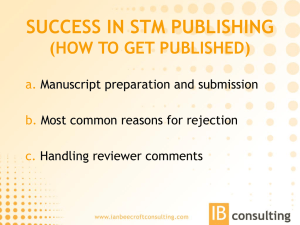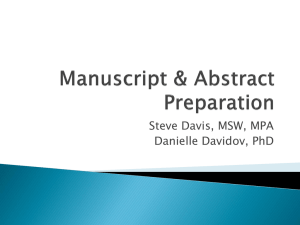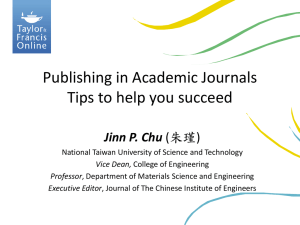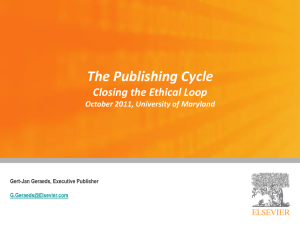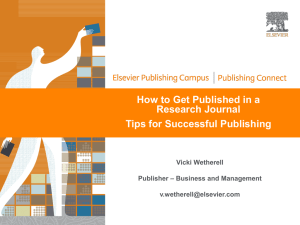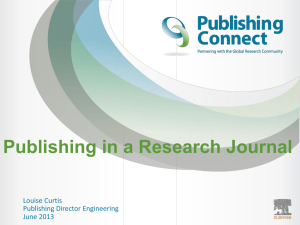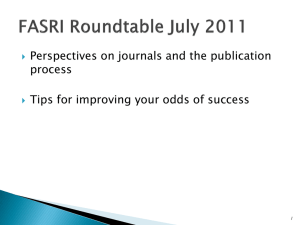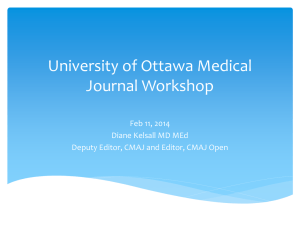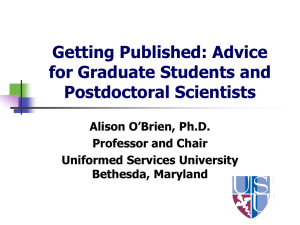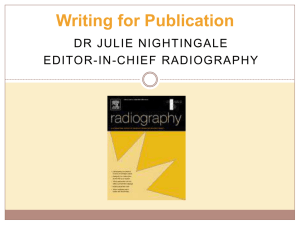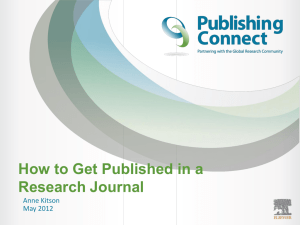What is a good manuscript?
advertisement
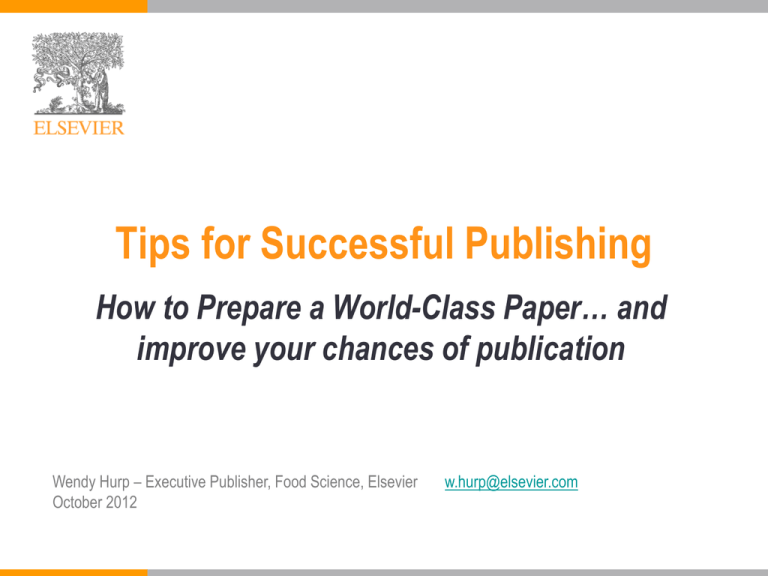
Tips for Successful Publishing How to Prepare a World-Class Paper… and improve your chances of publication Wendy Hurp – Executive Publisher, Food Science, Elsevier October 2012 w.hurp@elsevier.com Outline An introduction to food science research Are you ready to publish? Where should you publish? What is a good manuscript? How to prepare a good manuscript Revision and response to reviewers Responsibilities of editors, authors and reviewers Ethical issues in publishing Conclusion: what leads to ACCEPTANCE 2 An introduction to food science research Elsevier publishes more than 20 journals related to food across a number of different portfolios (food science, toxicology, neuroscience…) In 2011, more than 23,500 papers were submitted to these journals; 6500 papers were published in these journals In the first 6 months of 2012, more than 13,600 papers were submitted 3 We are launching 3 new journals! Food Bioscience – editorial office based at Jiangnan University Bioactive Carbohydrates and Dietary Fibre – Editor in Chief Dr Steve Cui Food Structure – will be accepting submissions in November 2013 4 Food Science output by country 4000 3500 scholarly papers 3000 2500 2000 1500 1000 500 0 1996 1997 1998 1999 2000 2001 2002 2003 2004 2005 2006 2007 2008 2009 2010 publication year Brazil China Korea, Republic of Russian Federation Spain United Kingdom United States 5 Food Science Research Output Scholarly papers 1996 2001 2010 1996-2010 CAGR 2001-2010 CAGR 2006-2010 CAGR Brazil 100 162 1165 19% 25% 27% China 52 252 1532 27% 22% 19% Korea, Republic of 83 201 724 17% 15% 22% Spain 515 602 1256 7% 9% 5% United Kingdom 743 784 822 1% 1% 1% 2873 2987 3685 2% 2% 5% United States Source: Scopus Growth of published articles from China 1800 1600 1400 1200 1000 800 600 400 200 0 1996 1997 1998 1999 2000 2001 2002 Food Science Els arts 2003 2004 2005 2006 2007 2008 2009 2010 Food Science All arts Source: Scopus 7 The increasing impact of these articles 1.2 1 0.8 0.6 0.4 0.2 0 2000 2001 2002 2003 2004 2005 2006 2007 2008 2009 2010 Source: Scopus 8 Most active institutes in food science 2006-2010 Full Institute Nam e Article Count Citation Count Average Cites Field Weighted Im pact Institute Collaborati Collaborati on % on Count China Agricultural University 715 2388 3.34 0.96 499 69.8 % Zhejiang University 618 2615 4.23 0.90 313 50.6 % Chinese Academy of Sciences 297 1332 4.48 1.35 275 92.6 % Jiangnan University 291 474 1.63 0.90 178 61.2 % Nanjing Agricultural University 250 825 3.30 1.02 147 58.8 % South China University of Technology 232 901 3.88 1.24 147 63.4 % Southern Yangtze University 222 1308 5.89 0.96 126 56.8 % Chinese Academy of Agricultural Sciences 191 590 3.09 0.87 158 82.7 % Huazhong Agricultural University 182 460 2.53 0.78 113 62.1 % Shanghai Jiaotong University 129 441 3.42 0.86 89 69.0 % Northw est A&F University 120 273 2.28 0.79 97 80.8 % Ministry of Education China 100 420 4.20 1.37 79 79.0 % The University of Hong Kong 97 660 6.80 1.37 70 72.2 % Graduate University of Chinese Academy of Sciences 90 304 3.38 1.16 89 98.9 % Sichuan University 86 333 3.87 1.16 51 59.3 % Ministry of Agriculture of the People's Republic of China 82 225 2.74 1.02 70 85.4 % Nanchang University 80 376 4.70 1.43 62 77.5 % Ocean University of China 80 221 2.76 0.85 52 65.0 % Northeast Agricultural University 72 151 2.10 0.82 44 61.1 % Tianjin University of Science & Technology 70 194 2.77 1.05 42 60.0 % 9 Are you ready to publish? You should consider publishing if you have information that advances understanding in a certain scientific field This could be in the form of: Presenting new, original results or methods Rationalizing, refining, or reinterpreting published results Reviewing or summarizing a particular subject or field 10 Can I publish this????? Have you done something new and interesting? Have you checked the latest results in the field? Have the findings been verified? Have the appropriate controls been performed? Do your findings tell a nice story or is the story incomplete? Is the work directly related to a current hot topic? Are the results of interest to a wide audience? Have you provided solutions to any difficult problems? 11 An international editor says: “The following problems appear much too frequently” Submission of papers which are clearly out of scope Failure to format the paper according to the Guide for Authors Inappropriate (or no) suggested reviewers Inadequate response to reviewers Inadequate standard of English Resubmission of rejected manuscripts without revision Paul Haddad, Editor, Journal of Chromatography A 12 …and my own publishing advice is: Submit to the right journal Submit to one journal only Do not submit “salami” articles Pay attention to journal requirements and structure Check the English – ask a native English speaker for help Pay attention to ethical standards Ask your colleagues to proof read the article Be self-critical 13 Where should you publish?? Do you want to reach specialists, multidisciplinary researchers, or a general audience? You will need to adjust information and writing style accordingly Journals, even in similar subjects, reach readers with different backgrounds Each journal has its own style; read other articles to get an idea of what is accepted Is the readership worldwide or local? 14 What about the Impact Factor? the IF can give guidance but should NOT be the sole reason to submit to a journal. The IF indicates the cites to recent items / number of recent items (published in a 2 year period) in a journal 2011 Impact Factor Cites in 2011 to articles published in: 2010 = 834 Number of articles published in: 2010 = 316 2009 = 788 2009 = 199 Sum: 1622 Sum: 515 Calculation:Cites to recent articles 1622 =3.150 Number of recent articles 515 15 What influences the Impact Factor? Editorial policies of journals can influence the number of citations/article, which in turn will influence the IF. The turnover of research in a certain field influences the IF as more recent citations will be made in a very “fast” area like genetics (bear in mind the IF window of two years). The article type influences the IF, reviews are generally better cited. Average cites per item 4 3 2 1 0 1996 1997 1998 1999 2000 2001 2002 2003 2004 2005 2006 2007 Article Review Conference Paper Source: 16 WARNING! DO NOT gamble or take risks by submitting your manuscript to several journals. Only submit once! International ethical standards prohibit multiple/simultaneous submissions, and editors DO find out – and your paper will be rejected. DO NOT resubmit a paper rejected by another journal without undertaking major revisions 17 What is a good manuscript? A good manuscript makes readers grasp the scientific significance easily It has a clear, useful and exciting message It is presented and constructed in a logical manner 2009 Nobel Prize for Physiology or Medicine awarded to Elizabeth Blackburn 18 How to prepare a good manuscript Decide which type of paper is most appropriate Full articles/original articles/research articles Review papers/perspectives Letters/rapid communications/short communications 19 Preparations before starting: Read the Guide for Authors CRITICAL ADVICE Apply the Guide for Authors to your manuscript, even to the first draft (text layout, paper citation, nomenclature, figures and table, etc.). It will save your time, and the editor’s. 20 21 Some technical details Pay attention to length of manuscript Consider supplying data as supplementary material Text layout Always number the pages, and number the lines Abbreviations Names of potential reviewers – authors in your subject area, not collaborators or friends, international Include a strong cover letter with your submission Check the Guide for Authors of the selected journal for specific instructions – not all guides are the same! 22 Characteristics of good writing • • • • • • • Good writing possesses: Clarity Conciseness Correctness (accuracy) Good writing avoids: Repetition Redundancy Ambiguity Exaggeration 23 Do publishers correct language? Sometimes… Publishers often provide suggestions of resources for authors who are less familiar with the conventions of international journals , but these are generally author-pays services. Traditional copyediting by the publisher is rare. Some publishers may perform technical screening prior to peer review But… It is the author’s responsibility to use proper language prior to submission Copyediting is only done after an article is accepted and is done by typesetters, not editors 24 Final checks before submission Ask colleagues to read and be critical All requirements from Guide for Authors are met Scope of paper is appropriate for journal Have your manuscript checked for language, either by a native English speaker or an editing service Ensure that the literature cited is balanced and that aims, purpose and significance of results are clear All listed authors agree to the submission Use a spellchecker! 25 Example from one journal’s Guide for Authors “…..The Editor-in-Chief and Editors have the right to decline formal review of the manuscript when it is deemed that the manuscript is 1) on a topic outside the scope of the Journal, 2) lacking technical merit, 3) focused on foods or processes that are of narrow regional scope and significance, 4) fragmentary and provides marginally incremental results, or 5) is poorly written.” Make sure your manuscript does not fall in any of these categories or it will fail at the first hurdle! 26 How to respond to a request to revise your paper Be positive – the reviewers think there is merit to your paper, or it would have been rejected Prepare a detailed letter of response State specifically what changes you have made to the manuscript. Provide a scientific response to the comment you accept; or a convincing, solid and polite rebuttal to the point you think the reviewer is wrong. Revise the whole manuscript Minor revision does NOT guarantee acceptance after revision. 27 …and if your paper is rejected Don’t be desperate – it happens to everybody Try to understand WHY, consider reviewers advice Be self-critical If you want to submit to another journal, begin as if you are going to write a new article. Read the Guide for Authors of the new journal, again and again. 28 Accepting rejection – and moving on Suggested strategy for submitting elsewhere: In your cover letter, declare that the paper was rejected and name the journal Include the referees reports and show how each comment has been addressed Explain why you are submitting the paper to this journal; is it a more appropriate journal? 29 Editor, reviewer and author responsibilities towards each other All parties should carry out their duties with respect and fairness Every effort should be made to handle papers and make editorial decisions within a reasonable amount of time Authors should undertake to complete revisions within the expected timescale Expectations should be managed realistically Problems should be reported to the journal/editor within a reasonable timeframe 30 Ethical issues in publishing Unethical behaviour can earn rejection and even a ban from publishing in some journals. Unethical behaviour includes: Scientific misconduct Falsification or fabrication of results Publishing misconduct Plagiarism Different forms / severities The paper must be original to the authors Duplicate/multiple submission Redundant publication Failure to acknowledge prior research and researchers Inappropriate identification of all co-authors Conflict of interest 31 Publishers have tools to detect plagiarism 32 Elsevier has advice for authors on ethics issues www.ethics.elsevier.com 33 We have an Ethics Toolkit 34 Consequences of breaking ethical rules Authors of this article committed plagiarism. It won’t be removed from ScienceDirect. Everyone who downloads it will see the reason for retraction 35 Authorship disputes Author: someone who has made substantive intellectual contributions to a published study Authors should... make substantial contributions to conception and design, acquisition of data, or analysis and interpretation of data AND draft the article or revise it critically for intellectual content AND have final approval of the version to be published Definition can vary per discipline and even per university All authors must agree to have their name included on the paper Definitions from: http://www.icmje.org 36 What leads to acceptance??? Attention to details Check and double check your work Consider the reviewers’ comments English must be as good as possible Presentation is important Take your time with revision Acknowledge those who have helped you New, original and previously unpublished Critically evaluate your own manuscript Ethical rules must be obeyed Nigel John Cook Editor-in-Chief, Ore Geology Reviews 37 A final thought….. If your paper is accepted, you may be asked to review papers for the journal in future. Please accept this invitation – your accepted paper is only published thanks to the work of editors and other reviewers, and your participation in the review process will be a positive contribution to the scientific community. 38 For more information Each journal has its own website with information on aims and scope, and links to guides for authors Visit www.elsevier.com/foodscience for a list of food science journals and links to these pages Visit the Authors Home page for even more information: www.elsevier.com/authors Download a copy of the booklet “Understanding the Publishing Process in Scientific Journals” from www.elsevier.com/publishingprocess Learn more about advancing your research career at http://www.biggerbrains.com/ Download the free book “Charting a Course for a Successful Research Career” from http://www.biggerbrains.com/featured 39 Download this booklet online! 40 Any questions? Thanks for listening!! 41
